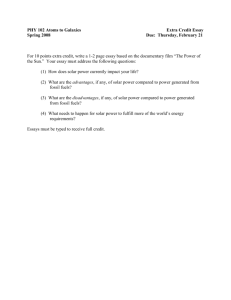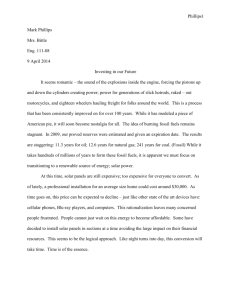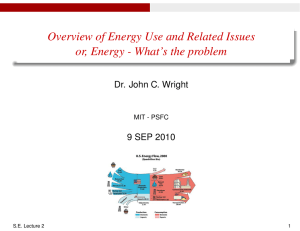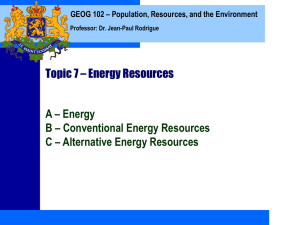Notes on Energy Resources
advertisement
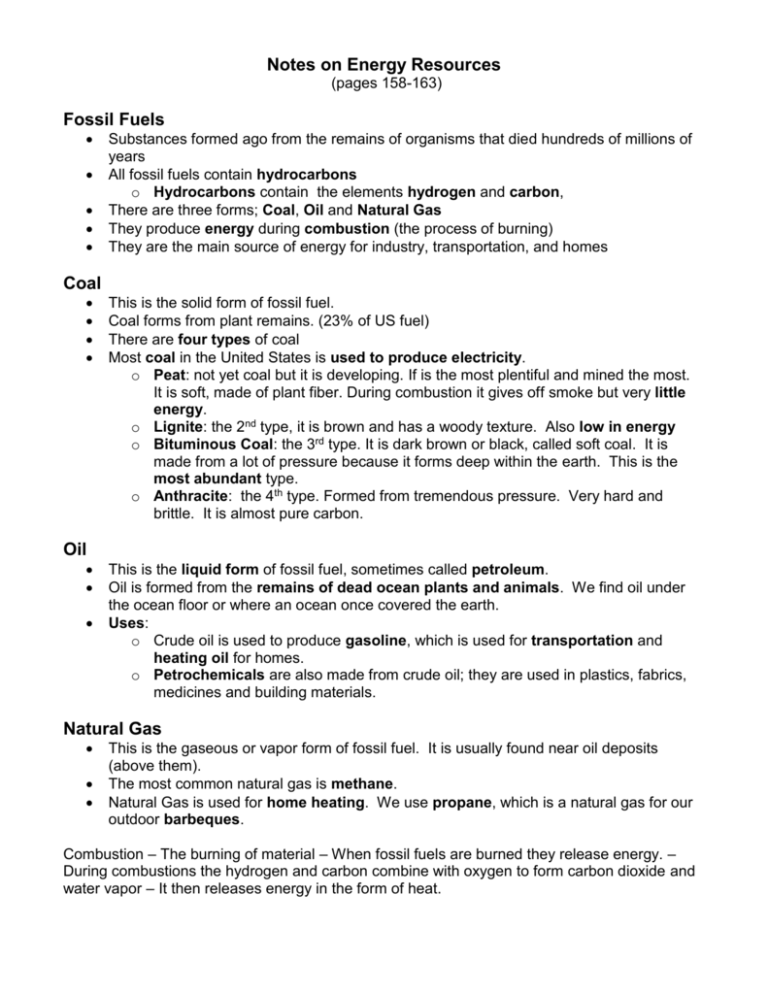
Notes on Energy Resources (pages 158-163) Fossil Fuels Substances formed ago from the remains of organisms that died hundreds of millions of years All fossil fuels contain hydrocarbons o Hydrocarbons contain the elements hydrogen and carbon, There are three forms; Coal, Oil and Natural Gas They produce energy during combustion (the process of burning) They are the main source of energy for industry, transportation, and homes Coal This is the solid form of fossil fuel. Coal forms from plant remains. (23% of US fuel) There are four types of coal Most coal in the United States is used to produce electricity. o Peat: not yet coal but it is developing. If is the most plentiful and mined the most. It is soft, made of plant fiber. During combustion it gives off smoke but very little energy. o Lignite: the 2nd type, it is brown and has a woody texture. Also low in energy o Bituminous Coal: the 3rd type. It is dark brown or black, called soft coal. It is made from a lot of pressure because it forms deep within the earth. This is the most abundant type. o Anthracite: the 4th type. Formed from tremendous pressure. Very hard and brittle. It is almost pure carbon. Oil This is the liquid form of fossil fuel, sometimes called petroleum. Oil is formed from the remains of dead ocean plants and animals. We find oil under the ocean floor or where an ocean once covered the earth. Uses: o Crude oil is used to produce gasoline, which is used for transportation and heating oil for homes. o Petrochemicals are also made from crude oil; they are used in plastics, fabrics, medicines and building materials. Natural Gas This is the gaseous or vapor form of fossil fuel. It is usually found near oil deposits (above them). The most common natural gas is methane. Natural Gas is used for home heating. We use propane, which is a natural gas for our outdoor barbeques. Combustion – The burning of material – When fossil fuels are burned they release energy. – During combustions the hydrogen and carbon combine with oxygen to form carbon dioxide and water vapor – It then releases energy in the form of heat. We are having a shortage of fossil fuels. This is why fuel costs are rising. Energy use in the United States keeps increasing. The United States contains only 5% of the world’s population, however we use more than 30% of the energy produced in the world today! Scientist predict that in the past 5000 years we have used up almost all of the coal, oil and natural gas formed over a period of 500 million years. We are running out! Solar Energy Life would not exist without the sun’s energy It can be used to heat buildings and to produce electricity. There are two types of Solar energy: o Passive Solar heat: When the sun is shining the energy is given off, when it is not, there is no energy. In this form there is no collection or storage of energy. o Active Solar heat: This is a system where a device called a solar collector is installed. It absorbs the sun’s energy and traps the heat. It also used water to transfer the heat. o Solar cells: Science has recently advanced our solar energy systems with the invention of solar cells. These are like batteries that collect the energy for future use. Many car manufacturers are experimenting with solar-powered cars that use these photovoltaic cells (solar batteries). Up until recently they were too expensive and produced too little power. o Solar Power Towers: These are power plants that use mirrors to reflect the sun’s energy into a boiler. The boiler converts water to steam, which turns a turbine and produces electricity. Wind Energy Wind energy is an indirect form of solar energy (caused by the uneven heating of the atmosphere) Windmills have been used since the 1800’s to power water pumps. Now they are used to product electricity. Wind generators are not always reliable; they need a constant source of wind so they are only used in certain areas. Water Energy Also a form of indirect solar energy. Used to produce electricity. Hydroelectric power: The use of running or falling water to produce electricity. Dams hold back millions of tons of water. It flows through turbines to product electricity. It is also a limited energy source because there are only a few locations where dams can be built. Nuclear Energy The way in which our sun produces energy is through something called nuclear reactions. Scientists have used this knowledge to duplicate this type of reaction on Earth. All objects on earth contain matter. All matter is made up of tiny particles called atoms. The center of the atom is called the nucleus (this is where the term nuclear energy comes from) Nuclear Fission: When an atom splits into two sections energy is released. There are certain elements that are easy to “split” and cause a chain-reaction. These elements are considered radioactive (able to produce nuclear energy). Nuclear Power Plants: These plants are where nuclear fission takes place. They use the energy released to heat water into steam, which turns a turbine and produces energy. There are problems with this type of energy. The radioactive materials are dangerous and harmful to the environment; radioactive leaks are possible, and security is threatened. Nuclear Fusion: When two atoms combine together into one large nucleus it creates much more energy than nuclear fission. It uses the hydrogen atom. Scientist have not yet been able to generate enough energy to do this yet, however it would be safer and less polluting. Alternative Energy Sources We are running out of current energy sources and pollution problems exist with many of the current sources. Geothermal: Geo: means earth Thermal: means heat Geothermal means the heat energy from the earth. o Magma within the earth heat up in certain spots near the surface. Water comes in contact with these spots, it heats and bursts out as steam. We call this release of steam a geyser. A famous geyser is “Old Faithful” in Yellowstone National Park. We can use this steam energy to produce electricity. o This is a limited source of energy because there are only a few places on earth where hot spots exist. Tidal Energy: o This can be used where the difference between high and low tides are great. o Used to produce electricity. o Can only be used in a very limited area where tidal plants can be built. Biomass: o Materials that come from living things. o They can be burned directly to produce energy or turned into other fuels. o Wood, plants, animal wastes are used to produce heating energy o Burning Garbage is another example (American Refuel) o Gasahol – this is when biomass from corn, wheat or barley is turned into fuel o Limited in the amount of energy produced and pollution problems. Hydrogen Power: o Hydrogen is available everywhere from the water (H2O) on earth. o It can be burned instead of fossil fuels. o Problem is the amount of energy used to separate out the hydrogen from the oxygen in the water is more than the energy that it produces!




